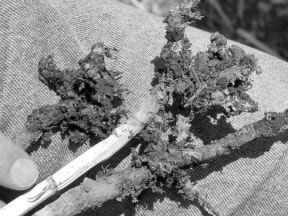A serious soil-borne disease is making its way across Alberta and is in central Alberta. Although clubroot is not a new disease to Alberta, it has recently been found on canola and is causing major concern as it continues to spread.
Shayne Steffen, manager of agricultural services for Ponoka County believes that it’s just a matter of time before it hits Ponoka.
“Anything can spread it,” he said. “It can be transported by dirty trucks, field equipment, wind, wildlife and everything else. I think that if we look hard enough we might find it in this area right now. It’s already in Wetaskiwin and Camrose so I’m pretty sure we will find some of it this year.”
The seriousness of the disease is enhanced by its longevity, surviving in the soil for up to 20 years.
There are methods farmers can adopt to help contain the disease if it is found in their fields and try to prevent it from spreading. The most effective way is for farmers to use long rotations between canola crops for four years or more.
“Probably the best way to help the situation is to ban fields and do crop rotations,” said Steffen.
“It’s important not to grow canola back to back.”
Steffen realizes the good prices of canola and understands that farmers will want to grow it again this year. His concern is that farmers will not be bringing in the money they expect if their fields are hit by clubroot.
“Canola prices are really high right now so there will be a lot of producers who will want to do canola again next year,” he said. “But if there is a 100 per cent infection rate in the field the losses will be 50 per cent or greater. That’s less than breaking even, producers will be spending more money growing it than they will get out of it.”
Another way to manage clubroot is to clean soil and crop debris from machinery. Greg Jones, a local canola farmer, believes cleaning field equipment between fields is important to keeping clubroot under control.
“One of the major ways it spreads is by machinery,” he said. “If they have it on their farm they should clean their machinery between fields so they can keep it contained. The amount of clubroot will probably depend how careless people are with cleaning their machinery before heading to another field. If they are not that vigilant it will spread.”
These ways to contain the disease may slow down farmers and even upset them but Steffen believes these ways are crucial to keep it from spreading to neighboring farms.
“The service board knows the significant impact and they are doing everything they can to help,” he said. “We’re not picking on farmers, we’re trying to protect everyone in the county. People may be angry at first but if their neighbors had it they would want it to be enforced to keep it from coming across the fence.
Steffen also stresses that if the disease is found it’s very important that producers don’t try and hide it.
Jones believes that trying to cover it up will only add more strain to the problem.
“If they try and hide the clubroot it’s their own peril,” said Jones. “It’s only going to make it a lot worse for them in the long run.”
Land will be tested random and if clubroot is found it is possible that the field may be quarantined from growing canola for five to seven years under the Agricultural Pest Act.
“This is a big issue for the service board,” said Steffen. “We will be sampling fields at random mostly focusing on the East and North borders (of Ponoka County). If we find a positive sample we will go back and test again to make sure, if we find two positive samples then we will quarantine the area. If a small amount is affected it will be quarantined for five years and if it’s a large amount that is found then it will be seven years.”
To help give information about clubroot and what farmers can do to help prevent it, Ponoka County is hosting a meeting on Feb. 13 at the Ponoka Legion at 5:30 to 8:30 p.m.
Ponoka County deputy reeve Gawney Hinkley encourages anyone involved with farmland to attend this meeting and learn about clubroot and methods that will help protect the fields.
“It’s really important that people show up to this meeting, it’s the information station and we’ll be able to talk with producers face to face.”
Ponoka County has also brought in educated speakers to address this issue. Dr. Kelly Turkington, a research scientist with Agriculture and Agri-Food Canada and Curtis Henkelmann with Leduc County Agriculture Services will be speaking.
“Turkington will be speaking on using computer simulation analysis potential distribution and severity of club root in western Canada and giving producers and industry a bit of heads up where it might be a potential concern,” said Turkington.
Also touching on some background on the disease risk forcast and implications of dealing with clubroot
“If we’re going to get this under control we will have to cooperate,” said Jones. “We are all in this together.”
